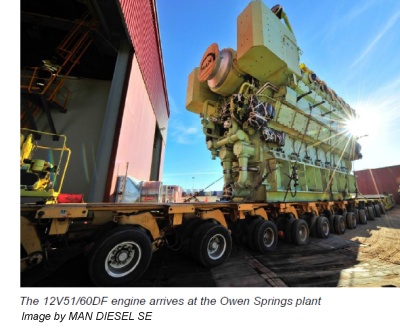|
MAN Diesel & Turbo Australia has also formed partnerships with local Australian suppliers and stakeholders as much of the equipment for the Owen Springs project must comply with Australian Standards. Niel Halvorsen, General Manager of MAN Diesel & Turbo Australia, says: “For many of our clients, our local engineering capability and supplier relationships are perceived as high-value attributes of our business.” Milestone The arrival of the first of Owen Springs’ three 10.9-MW generator sets marks a significant milestone in the project. The engine was originally loaded aboard a ship in Saint Nazaire, France in February 2010. It subsequently arrived in Darwin, capital city of the Northern Territory, in early April from where its 230-tonne bulk was transported to the site using multiple prime-movers and a low-loading trailer. The land journey took some six days via a carefully planned 1,500-km route. This first engine is scheduled for commissioning in July 2010 with the complete power station to be handed over to Power and Water Corporation in October 2010. Once operational, the Owen Springs power station will provide the highest efficiency open-cycle power supply in Australia. The Owen Springs Project PWC is a Northern Territory Government-owned corporation that services more than 80,000 customers and has 360 MW of existing power-generation capacity. The Owen Springs plant is based on three 10.9 MWe generator sets, each powered by a twelve-cylinder, vee-configuration 12V51/60DF engine. The generator sets will supply baseload power to the local grid in their gaseous-fuel mode, that is, burning natural gas ignited by a distillate fuel “micropilot”. At the time of signing the contract in 2008, PWC said: “MAN Diesel [& Turbo] Australia is an experienced company in power-station construction and its parent company in Germany specialises in dual-fuel engines in the size range required for this project. The contract specifications were technically complex as Power and Water was seeking world’s best practice in fuel efficiency and the lowest emissions of carbon dioxide per unit of electricity generated.” The MAN 51/60DF engine For power-generation applications, the 51/60DF is available in a nine-cylinder, inline version and in vee-configuration versions with 12, 14 and 18 cylinders. The engines have mechanical ratings of 1,000 kW per cylinder for 60-Hz power generation (514 rpm) and 975 kW for 50-Hz applications (500 rpm). These give an overall generator-set rating range of 8,560 to 17,550 kWe. With its fuel flexibility and low emissions, the MAN 51/60DF engine targets applications where operation on a back-up fuel is either essential or desirable. The engine’s fuel flexibility centres on the capability to operate on either gaseous or liquid fuel, and to switch between them seamlessly at full-rated output. In the gaseous-fuel mode, an air-gas mixture is ignited by injection of distillate diesel fuel. On the 51/60DF, the liquid fuel micro-pilot amounts to 1% of the quantity of liquid fuel needed to achieve full-rated output. It is injected via a common-rail system that allows flexible setting of injection timing, duration and pressure for each cylinder. This flexibility allows the engine to achieve low emissions and to respond rapidly to combustion knock signals on a cylinder-by-cylinder basis. In back-up, liquid-fuel mode, the 51/60DF engine operates as a normal diesel engine injecting distillate or heavy fuel oil (HFO) through a separate, normally dimensioned injector in a camshaft actuated, pump-line-nozzle system. At 500 mg/mn3 at 5% O2 on gaseous fuel, the 51/60DF readily achieves emissions of oxides of nitrogen (NOx) in compliance with both Germany’s TA Luft clean-air regulations and the World Bank Pollution Prevention and Abatement Handbook. MAN Diesel SE, Press Release |
||
|
|
 Australian Dual-Fuel Project Nears Completion
Australian Dual-Fuel Project Nears Completion
 MAN Diesel & Turbo Australia’s 33-MW Owen Springs Project, featuring the new 51/60DF dual-fuel engine, has taken a significant step with the arrival of the first of three generator sets at the new power plant. MAN Diesel & Turbo is constructing the Owen Springs plant, located near Alice Springs in Australia’s Northern Territory, for Power and Water Corporation (PWC), a major Australian public utility, with commissioning of the first engine expected in July 2010.
MAN Diesel & Turbo Australia’s 33-MW Owen Springs Project, featuring the new 51/60DF dual-fuel engine, has taken a significant step with the arrival of the first of three generator sets at the new power plant. MAN Diesel & Turbo is constructing the Owen Springs plant, located near Alice Springs in Australia’s Northern Territory, for Power and Water Corporation (PWC), a major Australian public utility, with commissioning of the first engine expected in July 2010.